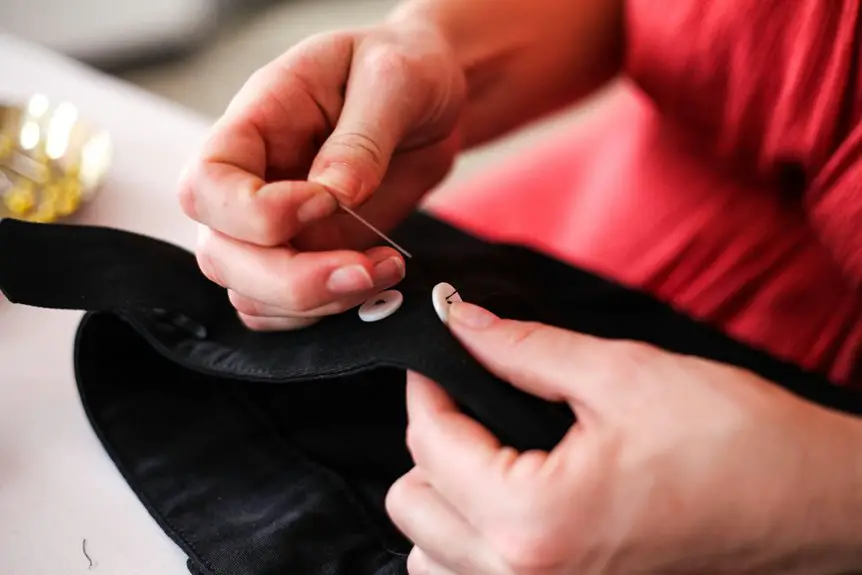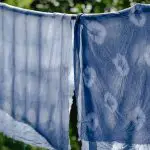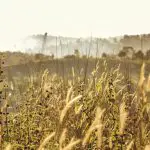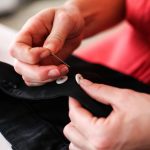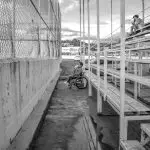You might think lawn fabric and batiste are the same since both are lightweight, fine cotton textiles, but they’re actually different. Lawn fabric is crisper with a tighter weave, giving it some structure and durability, perfect for summer dresses or even garden weed control. Batiste feels softer, more delicate, and drapes fluidly, often used for lingerie and baby clothes. If you want to understand their unique qualities and uses better, you’ll find more helpful details ahead.
Table of Contents
Key Takeaways
- Lawn fabric is crisp and slightly textured, while batiste is softer with a smoother, more polished surface and subtle sheen.
- Both are lightweight, breathable cotton fabrics, but lawn has a tighter weave and holds shape better than the more fluid-draping batiste.
- Lawn fabric is durable and suitable for summer dresses and shirts, whereas batiste is often used for lingerie, baby clothes, and delicate garments.
- Batiste’s finer weave makes it more delicate and semi-sheer compared to lawn’s sturdier, semi-sheer but more robust structure.
- Choosing between them depends on desired drape, texture, and garment use; they are similar but not the same fabric.
Definition of Lawn Fabric
Lawn fabric is a lightweight, plain-weave textile made from cotton or linen fibers. When you work with lawn fabric, you’ll notice its smooth, soft texture and slight crispness that sets it apart from other lightweight fabrics.
It’s breathable and thin, making it ideal for warm-weather clothing like blouses, dresses, and handkerchiefs. The tightly woven threads give lawn a delicate, semi-sheer appearance without sacrificing durability.
You’ll appreciate how lawn fabric dyes beautifully, offering vibrant colors and subtle patterns. Because it’s so fine, lawn fabric requires gentle handling during cutting and sewing to avoid puckering or distortion.
Definition of Batiste
Batiste shares many qualities with lawn fabric, such as its lightweight and fine weave, but it offers a slightly different texture and feel.
When you touch batiste, you’ll notice it’s incredibly soft and smooth, often made from cotton or cotton blends. It’s semi-sheer, allowing light to pass through gently, making it ideal for delicate garments and linings.
You’ll find batiste’s surface to be more polished than lawn fabric, giving it a subtle sheen. While both fabrics breathe well, batiste tends to drape more fluidly, which is why you’ll see it used in finer clothing and baby wear.
If you want something lightweight with a refined finish, batiste is an excellent choice that balances delicacy and durability.
Historical Background of Lawn Fabric and Batiste
You’ll find that both lawn and batiste fabrics have rich histories dating back centuries, each with unique origins and uses.
Knowing how these fabrics evolved can help you understand their differences and similarities better.
Let’s explore where they came from and how they’ve changed over time.
Origins of Lawn Fabric
Although both fabrics have rich histories, they originated in different regions and serve distinct purposes.
Lawn fabric first appeared in the 18th century, gaining popularity for its lightweight, smooth texture. You’ll find its origins primarily linked to:
- Lawn, Lincolnshire, England – The name “lawn” comes from this town, known for producing fine linen textiles.
- Linen to Cotton Shift – Originally made from linen, lawn later shifted to cotton, making it softer and more breathable.
- Summer Wear Use – Its light, airy quality made it perfect for warm-weather clothing, especially for women and children.
Knowing these points helps you understand why lawn fabric remains a staple for delicate, comfortable apparel, distinct from but often compared to batiste.
Batiste Fabric History
Fine, lightweight fabrics like batiste have long been cherished for their delicate texture and versatility.
When you explore batiste’s history, you’ll find it originated in the early 19th century, named after Jean-Baptiste, a French linen weaver. It was initially woven from fine linen, prized for its smooth, soft finish and semi-sheer quality.
As you use batiste, you’ll notice its lightweight structure made it ideal for handkerchiefs, baby clothes, and summer garments.
Over time, cotton replaced linen in many cases, making batiste more accessible while retaining its signature softness.
Understanding batiste’s roots helps you appreciate its subtle elegance and why it remains popular for delicate apparel and trims today.
This background sets the stage to compare it closely with lawn fabric next.
Evolution of Both Fabrics
Batiste’s delicate history gives you a glimpse into its refined character, but lawn fabric brings a different story worth exploring.
Both fabrics evolved to meet distinct needs, reflecting changes in textile technology and fashion.
Here’s a quick look at their evolution:
- Batiste originated in 19th-century France, prized for its fine weave and softness, often used in high-end garments and lingerie.
- Lawn fabric emerged in the 18th century, named after the English town of Lawn, focusing on durability and a crisp finish suitable for everyday wear.
- Advances in cotton processing and weaving techniques allowed both fabrics to become lighter and more breathable, adapting to modern demands.
Understanding this evolution helps you appreciate their unique qualities beyond just appearance.
Fiber Content and Weave Differences
When you compare lawn fabric and batiste, you’ll notice key differences in their fiber content and weave that affect their texture and use.
Lawn is typically made from long-staple cotton or cotton blends, giving it a smooth, crisp finish. Its weave is tight and plain, producing a sheer but sturdy fabric ideal for lightweight garments.
Lawn features a tight, plain weave of long-staple cotton, creating a smooth, crisp, and sheer fabric perfect for lightweight clothing.
Batiste, on the other hand, often incorporates fine cotton or a cotton-polyester blend, which can add softness and durability. Its weave is also plain but generally finer and more delicate than lawn’s, resulting in a lighter, softer fabric.
These distinctions mean lawn tends to hold its shape well, while batiste drapes more fluidly. Recognizing these fiber and weave differences helps you choose the right fabric for your specific sewing project.
Texture and Weight Comparison
Although lawn and batiste are both lightweight fabrics, you’ll find they differ noticeably in texture and weight. When you handle them, the distinctions become clear:
- Texture: Lawn has a crisp, smooth feel with a slight sheerness, while batiste is softer and more delicate, almost buttery to the touch.
- Weight: Lawn is generally a bit heavier than batiste, providing more structure without sacrificing lightness.
- Drape: Batiste drapes more fluidly due to its finer weave, whereas lawn offers a stiffer silhouette.
Knowing these differences helps you choose the right fabric for your project, whether you want a structured finish or a soft, flowing look.
Both fabrics serve distinct purposes despite their similarities in lightness.
Common Uses for Lawn Fabric
You’ll find lawn fabric is great for keeping your garden tidy by controlling weeds without chemicals.
It also helps protect soil during landscaping projects, preventing erosion and moisture loss.
Understanding these practical uses can show you why lawn fabric is a handy tool outside the textile world.
Gardening and Weed Control
Since controlling weeds is a constant challenge in gardening, lawn fabric offers an effective solution that you can easily use. This material blocks sunlight, preventing weed seeds from germinating while still allowing water and nutrients to reach your plants.
When you use lawn fabric, you’ll reduce the time and effort spent on weeding, helping your garden thrive.
Here’s how you can benefit from lawn fabric in your garden:
- Lay it down around flower beds and vegetable patches to stop weeds without chemicals.
- Cut holes in the fabric to plant directly through it, keeping weeds at bay.
- Secure the fabric with pins or staples to prevent it from shifting in windy conditions.
Using lawn fabric simplifies weed control and helps maintain a healthy garden.
Landscaping and Soil Protection
Beyond controlling weeds, lawn fabric plays a valuable role in landscaping and protecting soil.
When you lay lawn fabric, it helps prevent soil erosion by stabilizing the ground, especially on slopes or areas prone to heavy rain. This fabric allows water and air to pass through while keeping the soil intact, which supports healthy plant roots.
Using lawn fabric under mulch or decorative stones also keeps your landscape tidy by reducing soil splash and runoff. It’s a smart choice if you want to maintain your garden’s appearance without constant upkeep.
Plus, it limits soil compaction, so your plants get the oxygen they need.
Common Uses for Batiste
Batiste shines in projects that call for lightweight, breathable fabric with a soft touch. If you’re working on delicate sewing or fashion crafts, batiste is your go-to fabric.
Batiste is ideal for delicate sewing projects needing lightweight, breathable fabric with a soft, gentle touch.
Here are three common uses:
- Lingerie and Undergarments – Its softness and breathability make it perfect for comfortable, close-to-skin apparel.
- Baby Clothes and Accessories – You’ll appreciate how gentle batiste feels on delicate baby skin.
- Lightweight Blouses and Dresses – Use batiste when you want airy, elegant garments that drape beautifully.
With these uses, you’ll find batiste offers both functionality and refined aesthetics, especially when you need fabric that’s both soft and lightweight.
It’s not meant for heavy-duty or outdoor applications, so keep that in mind when planning your projects.
How to Choose Between Lawn Fabric and Batiste
When deciding between lawn fabric and batiste, consider the specific qualities you need for your project. If you want a lightweight, breathable fabric with a slightly crisper feel, lawn fabric is your best bet.
It’s great for summer dresses and shirts that require durability and a smooth finish. On the other hand, if you prefer a softer, more delicate texture with a subtle sheen, batiste is ideal.
It works well for lingerie, baby clothes, and lightweight blouses. Also, think about the drape—batiste tends to flow more gently, while lawn holds shape better.
Finally, check the fiber content; both are usually cotton, but blends can affect feel and care. Choose based on the fabric’s hand, drape, and your garment’s purpose.
Frequently Asked Questions
Can Lawn Fabric Be Dyed at Home?
You can dye lawn fabric at home since it’s a lightweight cotton, but make sure to use fabric dye suitable for natural fibers. Pre-wash, follow dye instructions carefully, and test a small piece first for best results.
Is Batiste Suitable for Upholstery?
Batiste isn’t ideal for upholstery because it’s lightweight and delicate. You might worry it won’t hold up, but it’s perfect for decorative pillows or light drapes where softness matters more than durability.
How Do Lawn Fabric and Batiste Respond to Washing Machines?
You’ll find lawn fabric handles machine washing well on gentle cycles, while batiste, being more delicate, needs cooler water and gentle care to avoid damage. Always check care labels before washing either fabric.
Are There Eco-Friendly Versions of Lawn Fabric?
You won’t believe how many eco-friendly lawn fabrics exist! You can find options made from organic cotton or bamboo, letting you create gorgeous, breathable garments without harming the planet. Just check labels carefully before buying!
Can Batiste Fabric Be Used for Embroidery?
You can definitely use batiste fabric for embroidery since it’s lightweight and smooth. Just make sure to stabilize it properly to prevent puckering, and you’ll get beautiful, delicate embroidered designs on this soft, fine cotton fabric.
- Does Chiffon Fabric Stink - July 15, 2025
- Does Chiffon Fabric Affect the Economy - July 15, 2025
- Does Cotton Fabric Have a Nap - July 15, 2025

